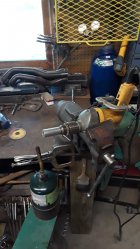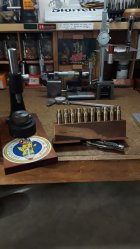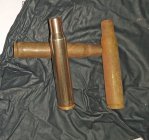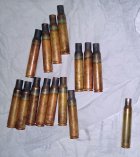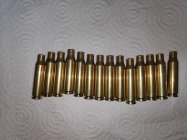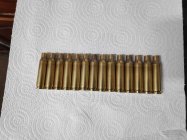I'd like to bring out a very valid point ; Everyone seems fixated on TIME or DWELL .
I don't believe there is a particular SET DWELL for open flame . Meaning torch temps will vary ,as do their flame shape and positioning relationship to the case it's self . Ambient temp. cold garage warm house Winter Summer . What I refer to as Variables .
It sounds to Me like a good number of you have spent some time as well as Money ,in the shooting arena .
So Might I suggest a Full or is it FOOL proof method

?. There are a # of Strain tension gauges within budget ,so as to verify what YOU'RE doing is correct for You .
Take some used cases which might be headed to the scrap bin ,a bullet or two in which ever calibers you're loading .
Drill an appropriate hole through the bullet's nose area ( what ever sticks out of the case mouth Not below it )
Now after seating your bullet in an empty annealed case , place either fishing line of appropriate strength or steel wire and pass it through the bullet up towards the nose ,tie it into a loop or use Nico press swage . Test Your neck tension on your bullet . You can use your press shell holder for the base anchor point ,run line up through where Your Die would be set gauge on top ,stroke downward ,see what the tension REALLY IS .
By YOU varying the Dwell and sizing your case seating that same bullet ( and case if you wish but it will need to be re work hardened before reusing it ) YOU will know exactly what You're doing in relationship to annealing . Some people want X amount of tension ,others X1/2 and XX . I'm sure You get the picture .
I've never annealed a usable case to where dis-colorization has passed more than 1/4" below the shoulder .
Look at a Lapua, Norma , LC or ?, to where their annealed or discolored . Stay Safe it's Not a race .
I've spent an inordinate amount of time inside my former employers Lab , in excess of 24 years ,as well as nearly double that in My own Lab . Prior to My retirement , I was employed as a Materials Processing Engineer for a well known aerospace company . However 90% of MY work was Structural composites ,along with adhesives as well as a variety of coatings . So I hardly qualify myself as some sort of expert in that realm .
The only time I've personally seen crystalized restructure on brass . Where I noticed it predominately ,was when it was allowed 28 + minutes at 800 F. approximately 427 C. recrystallization was visibly noticeable under magnification . I did that inside a tempering oven and NOT open flame .
I can say Nothing happened at 400 500 600 deg. even held at 30 minutes as that was MY baseline . Now at 700 F a slight change and at 800 F. Dramatic change . Again held 28-30 minutes .
FYI : I used a number of 7.62x51 cases and as I'd ruined them by oven heating ,Didn't bother testing hardness ,I simply tossed them into MY Brass scrap when I got home . Lattice or structure particle alignment was smaller by perhaps 2/3's and orientation was very noticeable . Every once in a while early on ,I'd take a case I had torched at home and polished into work ,then place it under magnification and I saw Nothing .
So, in essence, you have zero experience or production responsibility of ordinance in relation to deep drawn annealed cartridges with respect to the standard tests, slides, etc.? Should that mean you are qualified to judge who else is or isn’t an expert?
Recrystallization, which is partial but very easy to find in cartridge necks, starts as low as 530F, instantly. It would take a long time at 530F to get a clear slide, but that doesn’t mean is hasn’t started.
That also isn’t to say it has a strong effect on the tensile tests, but is in relation to protecting the risk to body strength.
You don’t see this in cups or pucks (bulk forms) but is critical in cartridge sections. This is why we say to use 400 F in body sections to prevent weakening.
I suggest we don’t make very assertive comments regarding indirect knowledge of cartridge production based on being in a related field, and without any direct experience.
Nothing wrong with finding papers and discussing them, but best to follow up with the ones well before them and after them. Cartridge making technology is tightly controlled and not often published in the open. However, the old references are not wrong about annealing or cartridge making versus bulk brass.
The two papers you cited have serious conflicts between them. Later work at Norma had these issues pointed out to them and they would not make the same comments today that they did when they published those papers with respect to recrystallization. To be blunt, nobody cares about the grain structure once the mechanical properties are established.
There are no references to time or temperature in that Norma paper, just the power level of an unspecified induction system. No doubt they achieved their hardness survey goals before they ran with those power settings, but it means nothing in terms of the tensile strength or yield point changes, which is what we are really after.
The Norma paper is of no use to an annealer at home. It gives no time or temp values for actual cartridge necks, and if it did they would not be measured in minutes or in an oven.
At the end of the day, the true value of annealing would be directly measured in terms of a stress strain chart, but we end up using HV as an indirect measurement due to the difficulty of setting up stress strain tests on similitude of thin samples which do not behave as puck or cups in standardized tests.
During my tenure as a Chairman in ASTM, I discovered the difficulty of getting a whole committee to accept a test method that is new or different. You find it takes more than 5 to 8 years worth of biannual meetings to get close to a consensus, which may or may not pass. What i concluded was I didn’t care if the tests became a standard or not, nor did I care what the grain structure did as long as the cartridges performed. There were far too many folks voting in committees that were far from experts or directly involved.
All of that stuff published in ASTM using heavy sections, ovens, cups or pucks, has no relationship to cartridge neck properties. It is only used as quality control background on the bulk purchase of cartridge brass and has almost no useful relationship to cartridge necks.










